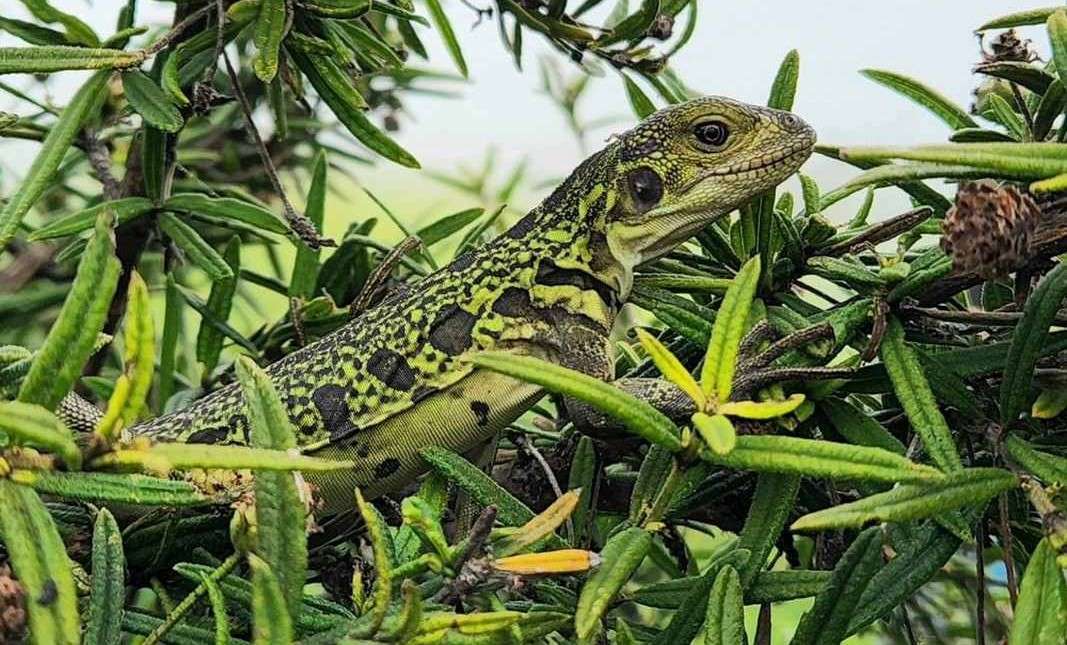Toddler is Best Friends With a Frog: They Eat Together, Watch TV, and Go on Walks-LOOK
A toddler in Florida is best friends with her rescue pet - a white tree frog she fell in love with at a pet store.

For the first time since the species was discovered in the Galápagos Islands, baby Galápagos pink iguanas have been seen in the wilds of those majestic islands.
First described in 2009, the species was immediately recognized as facing a serious risk of extinction. Only between 200-300 iguanas are thought to exist on Wolf Volcano on Isabella Island.
But after a ten-month expedition by the Galápagos National Park Directorate of Ecuador, and the Galápagos Conservancy of the U.S., it's confirmed that the species is still building nests, and still procreating; revealed by dozens of hidden cameras.
The cameras also confirmed the major threat to the pink iguanas are non-native feral cats, knowledge that while tragically garnered, will go a long way towards drafting a strategy that can save the reptile.
"Excellent news for our country! Pink iguana hatchlings and juveniles were discovered for the first time after years of research," cheered the Ecuadorian Minister of the Environment. "This is thanks to a collaboration between the GNPD and the Galápagos Conservancy. Congratulations to everyone who contributed to this discovery!"
A monitoring station has been set up on the remote Wolf Volcano to keep scientific eyes on these vulnerable reptiles.
First described in 2009, the species was immediately recognized as facing a serious risk of extinction. Only between 200-300 iguanas are thought to exist on Wolf Volcano on Isabella Island.
But after a ten-month expedition by the Galápagos National Park Directorate of Ecuador, and the Galápagos Conservancy of the U.S., it's confirmed that the species is still building nests, and still procreating; revealed by dozens of hidden cameras.
The cameras also confirmed the major threat to the pink iguanas are non-native feral cats, knowledge that while tragically garnered, will go a long way towards drafting a strategy that can save the reptile.
"Excellent news for our country! Pink iguana hatchlings and juveniles were discovered for the first time after years of research," cheered the Ecuadorian Minister of the Environment. "This is thanks to a collaboration between the GNPD and the Galápagos Conservancy. Congratulations to everyone who contributed to this discovery!"
A monitoring station has been set up on the remote Wolf Volcano to keep scientific eyes on these vulnerable reptiles.
"The discovery of the first-ever nest and young pink iguanas together with evidence of the critical threats to their survival has also given us the first hope for saving this enigmatic species from extinction." Paul Salaman, president of Galápagos Conservancy, said in a statement. "Now, our work begins to save the pink iguana."
The expedition was funded by Initiative Galápagos, a program in 2021 to reverse all species declines on the famous islands.
Last year WS reported the first ever major surveys of the animal on Isabella Island.
The challenges of conserving them are partly the terrain, for Wolf Volcano is as unwelcoming as a wolf or a volcano. The iguanas nest at 5,600 feet above sea level, where there is little shade, and the temperatures can rise to 100 °F, and 160 °F at the level of the ground. At night however, the temperature plummets to 50 °F with a strong, constant and freezing wind.
MORE ON THE GALAPAGOS: Iguanas Successfully Reintroduced to Galapagos Island After They Were Last Seen By Darwin 184 Years Ago
The steep, mountainous ground is littered with cacti, and there are more ticks on Isabella than any other island. Finally, the iguanas can easily bite a finger off if they get the opportunity, so handling them is kept to a minimum.
Islands, not least of which being the Galápagos, have benefitted more than perhaps any other ecosystem on Earth from conservation measures.
As disrupted as they have been from introduced species, they are about the only places on Earth where restoring the original ecosystem can be 100% successful, and WS has reported that on many islands this has absolutely been the case, through eradication of invasive species, and strict protections.
WATCH the story below…
SHARE This Good News Amid The Gloom Of The "Sixth Mass Extinction" Talk…
Be the first to comment